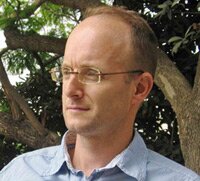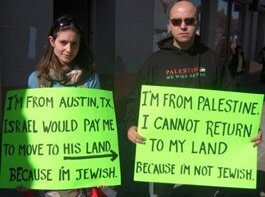A recent ruling demonstrates the bureaucratic machinery the state has created to restrict the Palestinians’ ability to enter, live and work on land west of the separation fence.
IOA Editor: This is an important news story which points to the ultimate effect of Israeli supreme court decisions: supporting Israel’s methodical process of ethnic cleansing, bit by bit — as the old Zionist saying goes, “duman here, and dunam there” — this time 9.5% of the West Bank territory. Next time what?
By Amira Hass, Haaretz – 11 Apr 2011
www.haaretz.com/print-edition/features/supreme-court-is-on-wrong-side-of-west-bank-separation-fence-1.355251
A recent ruling demonstrates the bureaucratic machinery the state has created to restrict the Palestinians’ ability to enter, live and work on land west of the separation fence

Amira Hass
Anyone who suspects the Supreme Court and its judges of leftism should read the latest ruling on “The Israeli Seam Zone Permit Regime.” In plain language, this is the bureaucratic machinery that the Defense Ministry and the Civil Administration have created to restrict to the absolute minimum Palestinians’ entry, time spent, and ability to live and work on lands in the West Bank that are west of the separation fence. To be more exact, it refers to Israel’s annexation of 184,868 dunams (about 45,682 acres ), for now, of Palestinian land trapped between the fence and the Green Line.
Read the ruling issued by the Supreme Court, sitting in its capacity as the High Court of Justice, in files 9961/03 and 639/04 from April 5 of this year, and you, the distrustful, will be put at ease.
With more than half a million settlers living in spacious settlements that encroach upon suffocating Palestinian enclaves, the court is still convinced Palestinian lands have been taken over for security reasons. Politicians regard the route of the separation fence as “the effective border between Israel and the Palestinian Authority,” but Supreme Court President Dorit Beinisch writes that “we can but hope that this is a need that is of a temporary nature, because alongside the need to fight terrorism, the uninvolved civilian population is, to our great regret, also harmed.”
Over the past eight years, except for certain sections that it ruled must be changed, the High Court of Justice has endorsed the invasive route of the separation fence (85 percent of which is within the West Bank, far from the Green Line, according to OCHA, the UN Office for the Coordination of Humanitarian Affairs).
The process was completed last week when the court handed down, without any fanfare, its rulings on two petitions, one submitted by Hamoked – the Center for the Defense of the Individual, in 2003; the other by the Association for Civil Rights in Israel, in 2004. The petitioners did not argue over the route of the fence, but over the dispossession of Palestinians from their lands, in practice, and the discrimination between Jews and Palestinians.
Stuck in between
The fence’s invasive route cuts off a considerable chunk of land – some 9.5% of the total area of the West Bank – from its natural owners, the Palestinian community. As a permanently declared closed military zone, only Israelis and tourists are permitted to enter, travel and hike there, and only Jews are permitted to settle there. The entry, movement and housing for Palestinians in those areas, meanwhile, is kept to a minimum. Three groups of the population are directly affected by this.
First of all, the tens of thousands of residents who live east of the fence but whose lands lie to its west. There are towns and villages that cannot expand or build as their natural growth would require. What is permitted for Alfei Menashe is forbidden to Qalqilyah; what is permitted for the settlement of Na’aleh is forbidden to Na’alin.
The second group directly affected includes those with the bad luck of having their homes situated in this in-between area: 3,000 people who are required to have a special permanent permit from the Civil Administration allowing them to live in their own homes. All the others – family members, friends, doctors, teachers, garbage collectors, TV technicians – must undergo an exhausting bureaucratic process to obtain a temporary permit (“for personal purposes” or “for infrastructure workers” or “for medical teams” ) to visit – and not everyone can get it, and not each time a request is submitted.
The third group is made up of the farmers whose lands are imprisoned behind closed gates, heavy locks and a cumbersome machinery of soldiers who are never in a hurry. In the beginning, the state had promised two-year agricultural permits. In 2006, 10,037 such permits were issued. Another 214 temporary permits were given to farmers whose claims to the land had not yet been decided. A total of 3,881 short-term work permits were also issued to agricultural workers and family members of farmers.
But since then, there’s been a steady decline in the number of permanent permits issued. In 2010, only 1,200 Palestinians received “permanent agricultural permits” for a period of more than one year, as the Civil Administration reported to ACRI just one week ago. Another 392 Palestinians received permits ranging in length from six months to one year, while another 1,167 got “agricultural permits in the seam area” – those whose rights to the land had not been made clear. On the other hand, the number of work permits issued skyrocketed to 18,630 – of these 8,583 were valid for one to three months, and 7,463 for six months to one year.
No problem for Beinisch
Overall this is okay, according to Beinisch and her colleagues on the bench, Eliezer Rivlin and Ayala Procaccia. Beinisch commented on the drop in the number of visiting permits issued “for personal purposes” (from 11,000 in 2007 to 5,200 in 2009 ) and asked the Civil Administration to be more flexible.
She also noted the fact that no reasonable timetable had been fixed within which to process the permit requests.
But “this time too,” Beinisch wrote, “we could not ignore the vital security purpose which lies at the basis of the decision to close the seam area… We came to the conclusion that, subject to a number of changes fully detailed above, the decision to close the seam area and to impose the Permits Regime there withstands the tests of legality and we therefore do not see reason for intervention on our part.”
She also took Moked to task for comparing the situation to apartheid.
What apparently does not concern the High Court in any way is the constant Israeli tendency to divide the Palestinian population into categories and sub-categories.
These sub-categories are recognizable by the lack of freedom of movement the Palestinians face on their own expanse of land. The drop in the number of “permanent farmers” offers further proof that Israel has made the bureaucratic process of determining Palestinian ownership of land even more complicated.
It allows temporary workers to go and work in the area. They may be the children or the grandchildren of the owners of the land, but their ownership is not recognized.
Will Israel decide in another 10 years that this land does not have any owners? And then the honorable High Court justices will be able to rule that this is indeed so, and that without an owner the Sovereign (Israel ) is permitted to do with the land as it wills?




















